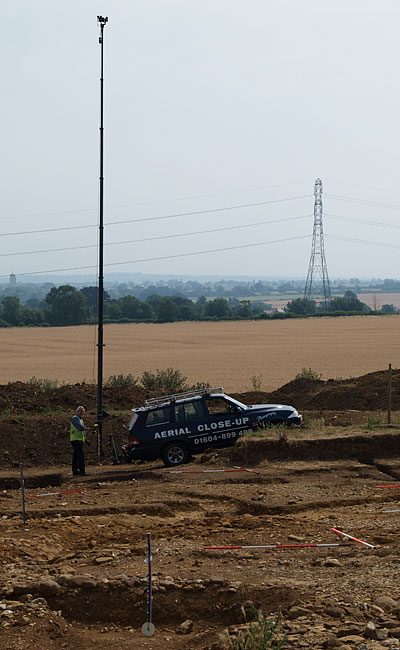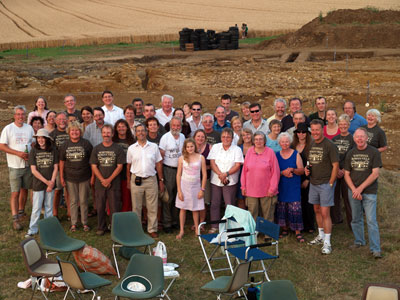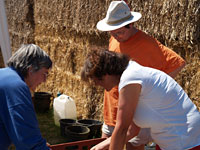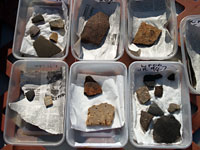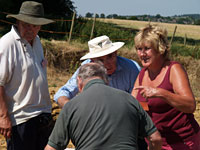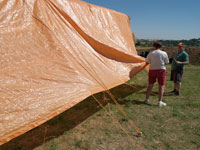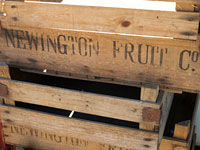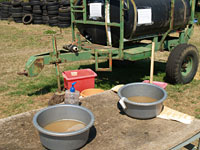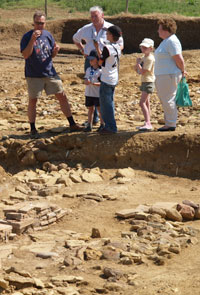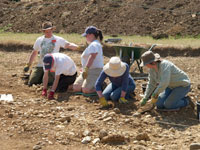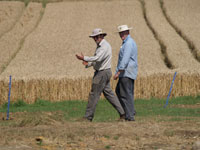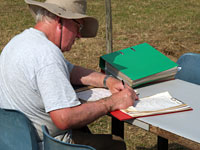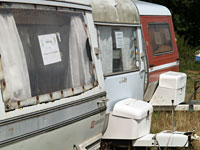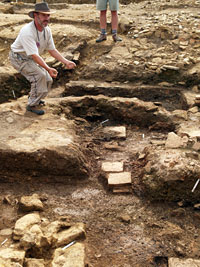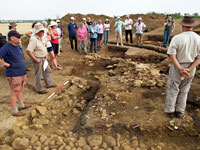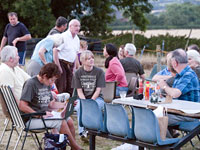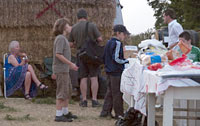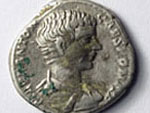 |
|
|||||||||||||||||||||||||||||||
|
|
AN OCCASIONAL PROGRESS REPORT Day 16 of 20, Monday 17th, July A scorcher of a day - the little breeze there was, was very warm. Way above heat exhaustion danger temperatures! Diggers beware. Expected to be even hotter tomorrow. Phew! Anyway, Dave H. will be OK...
He's got a new hat. This is at least partly so he and his gang can roam unrecognised and hunt down missing contexts. Any ideas for a collective noun for context-gatherers? Or perhaps a name for our trio? Down in the new bath house area (new readers please note that it may well not be a bath house, and therefore not the "new" one), they've uncovered a large slab which may be part of a very fat pilae...
The buckets are covering the first two pilae found down here last year. Just East of this, a new bit of foundation has been excavated...
Barbara - this time with Julia, and smiling - has moved over to the other side of the villa foundation to examine the ditch there...
Meanwhile Dave D. ...
... detected a substantial metal object in the spoil heap (oh the embarrassment of it!)...
Some reckon its a sort of pommel - might have been on a small dagger or a very small sword? And finally, an email received yesterday from Malcolm Caine:
Day 17 of 20, Tuesday 18th, July Yup, it was officially the hottest July day on record! Tomorrow will be even hotter. And to add to the climate chaos, today was the day the roof blew off! Your intrepid cameraperson was elsewhere at the time... but was there to record the aftermath...
So the big white gazebo has been folded away...
and a huge orange tarpaulin (previously used for the environment tent - which also blew away!) has taken it's place.
Some of us immediately thought of the sponsorship potential! As Chris said, it's Orange Wednesday tomorrow! "Orange puts the past in context"? So, much of the finds area now works in a kind of warm glow of light that makes the tiles look pale...
No major archaeological developments to report to day. But here are a couple of photos of painted plaster I took this morning:
Anthony Seminara, our friend who made the rotating animations of our burial's head and several pots (click here) spent a couple of hours photographing in the bath house - he's going to compile a virtual reality walkthrough! It will appear on this website in due course. Here are some more trivia:
Day 18 of 20, Wednesday 19th, July At the risk of repetition - it was the warmest July day on record! 36.3 degrees C registered somewhere near Gatwick: they must have had their air conditioning on because I'd put money on it being hotter than that here! It was windy too, providing much exercise for the new orange cover...
It made working in the finds area feel a bit like serving before the mast. Nobody was flogged though. One of last year's Time Team volunteers, Chris, came back for a re-shoot today and brought two air cadets with him, Antoni and Esther...
Thanks for your help on the upper villa range guys - sorry it was so hot. Here's a photo I took yesterday. It's the lowest side of room 3B - the famous sealed wet context that yielded up so many treasures to us. You can see that even un-sealed, it stays wet through the hottest weather...
It's really too hot in my humble garret to spend too long on this. So please excuse me if I cut it short. But before I go, a note to continue a conversation about the evolution of the English language (it started with a moan about the misuse of apostrophe's): as well as a female yellow wagtail, a new technical term has been noticed on site, attributed to Dr.M, supervisor in charge of the new bath house (so it must be genuine): chibble v. tr.: to trowel effectively but with caution; chibbleated adj. having been chibbled. Day 19 of 20, Thursday 20th, July A bit cooler today, but still quite humid. It rained lightly in the early hours of the morning, but no damage was done to the site. This morning was dominated by the activities of Aerial Close-Up Ltd and this blog is dedicated to John and Richard Buller for the fantastic service they have rendered us every year since 2001.
They're selling the business soon, so this will be the last year we'll benefit from their generosity and skill. They're a pleasure to work with and take a real personal interest in the development of the site from year to year. I know it's a real b****r to be cleared off the site when there is so little time left and a lot more to do, but the aerial close-up photos are an invaluable part of the site record which provide us with information we simply cannot get any other way.
Thanks John and Richard - and good luck with whatever you move on to next. We know you'll be back to visit next year, and look forward to welcoming you. Lots of cleaning, planning, measuring and a bit of digging this afternoon. I promise much more archaeology in the last-day-of-the-dig blog - but it won't be online until (probably) Monday, as it's the barbecue tomorrow evening and then the weekend. Meanwhile, Alan (planning) suggested that a collection of hats might be fun. So here are all the hats to be seen on site late this afternoon..
Barbara's RAF-supported break-away dig in the upper villa range is really taking off (sorry!)...
... They reckon they've found the edge of a compacted surface which probably pre-dates the villa range, and is possibly contemporary with round house 2.
They've found some colour-coated Nene valley pottery close to the join, and (just before close of play) a green patch, which almost certainly means a bronze remnant: Dave the Detector will be checking the green bit tomorrow (we hope) to see if it is metal. Now don't get too excited, but we have a record of turning up the most exciting finds on the last day of the dig - so, watch this space. And finally (apologies to English language purists - although not starting a sentence with "And" was only ever a Latin rule!)... Dr. M's proposed collective noun for context hunters is "a speculation". That's the winning entry so far! Only one actually. Oh well. Day 20 of 20, Friday 21st, July The last day arrived and there was a general feeling of winding up. Not in the teasing sense, of course, but in a mood of, I think, quiet satisfaction that deeds had been done. While some planned, others still dug, but not for long. The finds area ran out of finds to process, and by mid-afternoon had been dismantled and packed into the container for storage until next year. When the last planners cleared the new bath house area, yours truly did a quick photo shoot while Steve began the final site tour of the 2006 dig. I missed Barbara's talk about the break-away dig in the upper villa range. I was going to tickle her until she told me all about it, but Chris sent us the following press release. It is, Barbara assures me, a brilliant account of the proceedings:
Thanks Chris! All I would add is that round house two is now officially 4 metres less in diameter that it used to be - a shrinkage from 13m to 9m. And, obviously, it doesn't underlap the West wing, so the current sketch map of the villa and roundhouses (as on the CLASP site) will have to be amended. Click here for a quick "photomerge" compilation of the trench: some of the boundaries and colour changes are caused by the "photomerge" process, so don't base any theories on them! Steve then lead the tour onto the courtyard, where I joined in the latter part. The most exciting development is that between the East-West drain (in trench E) and the bath house, and just next to trench A, they have removed the post Roman courtyard surface and found a substantial layer of Roman remains...
Next year - says Steve - the whole of the paved courtyard is coming off to see the Roman remains below. Just to catch up, here's the post hole at the East end of trench B...
Down in the "new bath house" area (I'm going to call it "the mystery building" from now on), Martin layed out ranging rods to show us where he reckons the West wall (the back wall, presumably) was and a tentative stab at the position of the South wall...
The mathematics of the pilae...
shows that the room they are in was 5m wide. Apparently the double row of pilae would have been down the middle, so you can work from that. The circular feature...
... yielded up some fine coloured tesserae, so it's a good bet that there was a figured mosaic in this room. Martin reckons it was lifted out wholesale to be used elsewhere when this building was abandoned. Very little roof tile has been found in the mystery building, and much of the foundations have been robbed out: were these materials removed to be used in building the bath house just up the hill? Possibly. Pot and coin evidence suggests a 3rd century date for the mystery building, so it may that it is contemporaneous with the second phase of the development of the bath house. Both Martin and Steve were keen to emphasise that while we can construct and change scenarios to our hearts' content, we have no firm evidence for the use of the mystery building (no drains as would be expected in a bath house - but they might be further down the hill anyway) and we don't know its alignment yet - along the contour or cut into the hillside like the bath house. Much remains to be discovered next year - and beyond! Other bits and pieces: Here's a photo of the dressed stone, lined up as it may once have been in the villa - as a base for the portico or as a decorative feature...
And here's Jane's latest pottery assembly of a nice piece of colour-coated pot...
I have no photo of the dismantling of the pavilion - I was too tearful to see through the viewfinder. Here's the barbecue group photo complete with the rosy hue of a summer evening! Click on it for a bigger version... A photo of 'participants' only will appear in due course in the appropriate place. The barbie was excellent as usual - thank to Steve and Nick for cooking - and it was great to sit out above the site and not swelter!
A good time was had by all. So, here's to next year! PS The virtual tour of the bath house is already on the website! Click here. Sorry about the clutter left in vision. Some of the 2006 aerial photos will also be on-line as soon as I have them. APPENDIX C Notae Academicae 1.1 Neil suggests "contextualisers", which is accurate if mundane but might led to confusion with the term as used in other branches of historical and literary discourse. He also uses the term "Context Club" in the title of his email. 1.2 Malcolm has sent this offering:
2.1 My casual use in this blog of the term "context hunters" has provoked several emails from university departments of historical anthropolgy. Prof. René de Rien of Grenoble insists that "context gatherers" would be more appropriate, also suggesting an essentially nomadic existence. He conceded after several exchanges that "context hunter/gathers" might be acceptable. He'll get back to me. 2.2 Most interestingly, Dr. Strabismus of Utrecht argues that what "contextualisers/contextologists" do is in fact of an agricultural nature: they seed contexts and watch them grow before harvesting them and incorporating them into a consumable matrix. This would suggest a more settled way of life. 2.3 The University of Weedon is offering to fund a PhD student to research into this intriguing taxonomic issue. |
|
||||||||||||||||||||||||||||||
| ||||||||||||||||||||||||||||||||




















